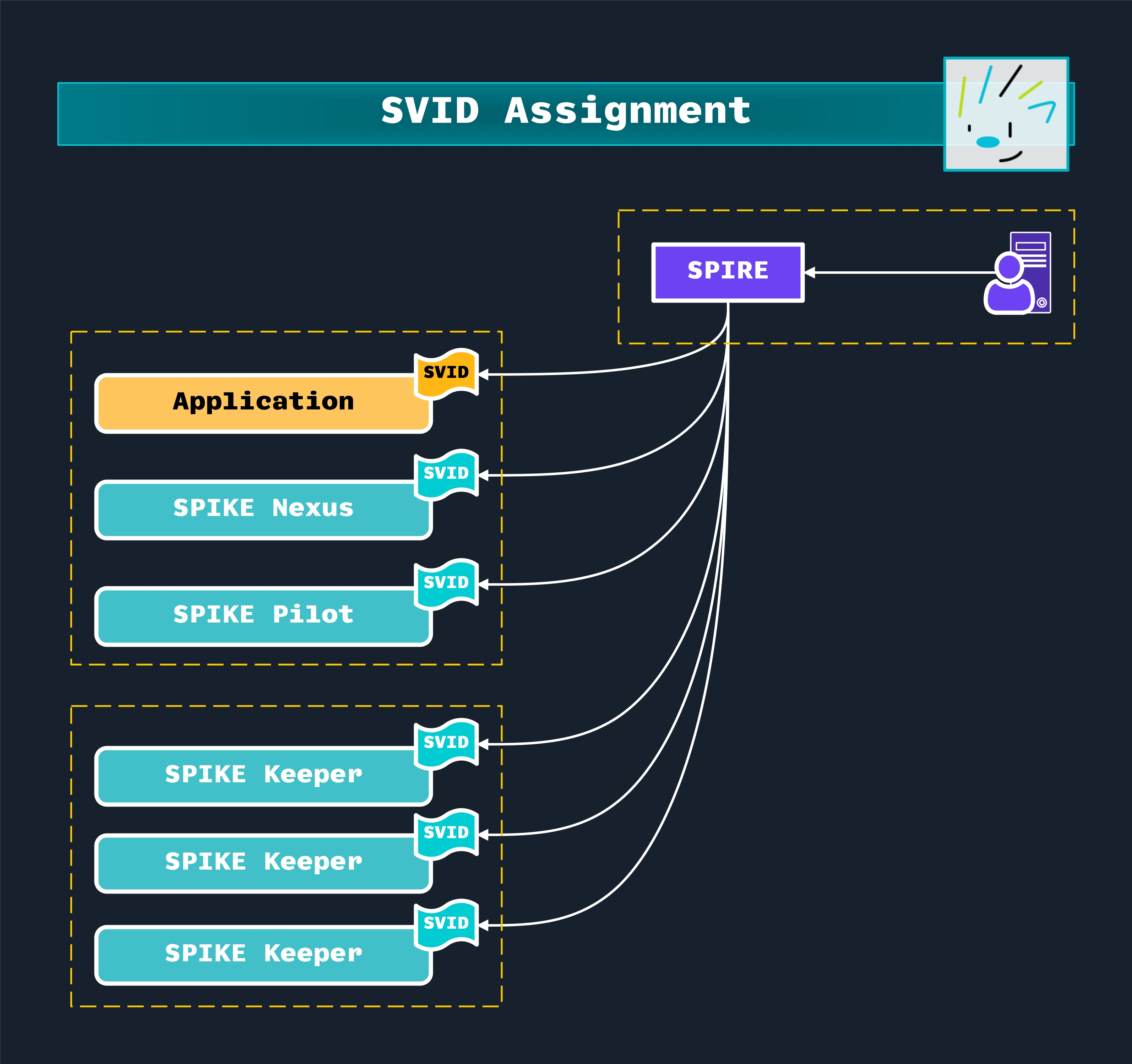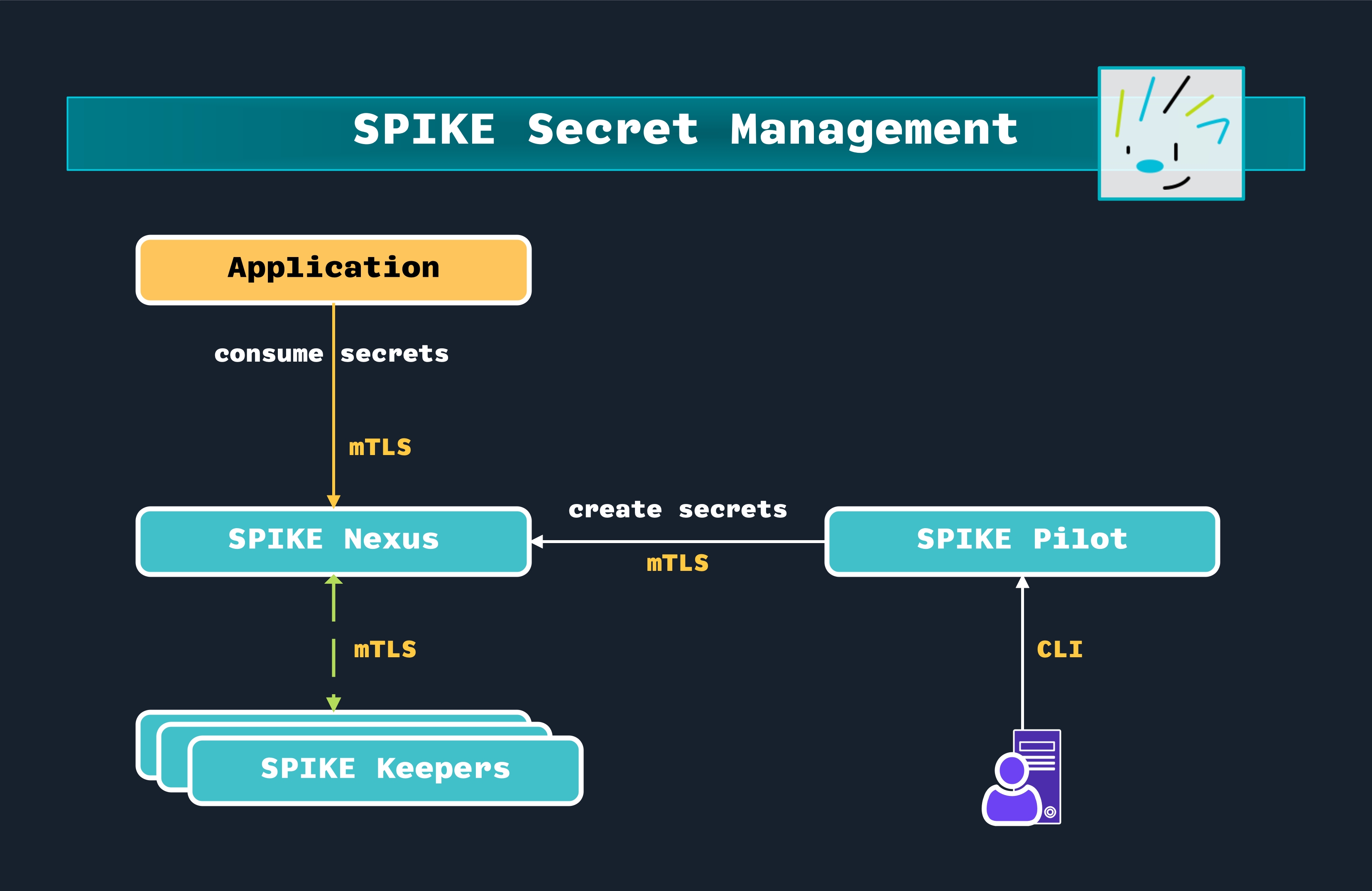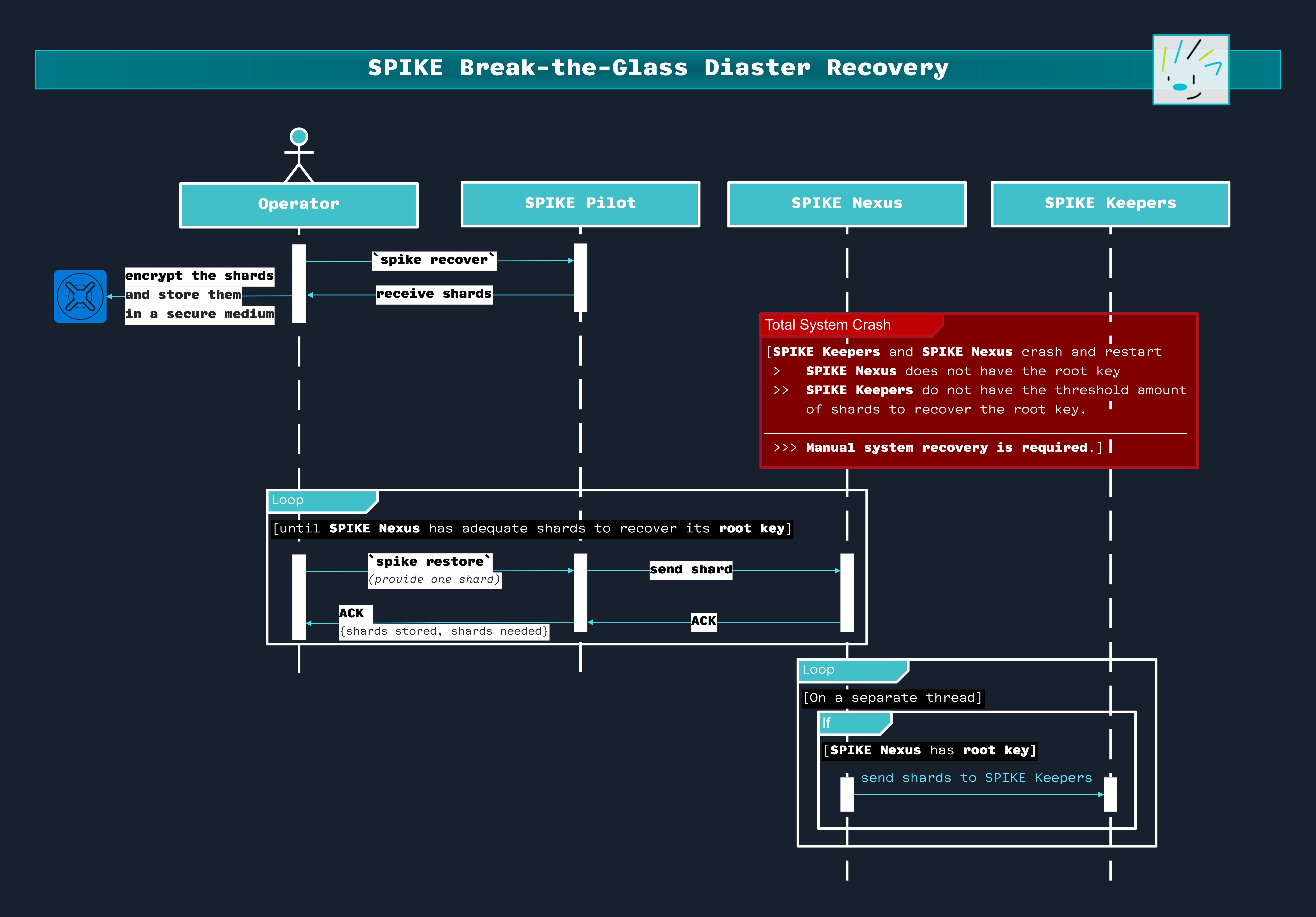⚠️ This Page Needs Work
With the recent introduction of SPIKE Bootstrap, some of the workflows mentioned in the page has slightly changed. Although the architecture and the trust model remain the same, the content of this page needs to be updated.
This notice will be removed once the page is updated.
SPIKE System Overview
This document provides an overview of SPIKE, a SPIFFE-native Secrets Management solution. It is designed to ensure secure storage, recovery, and management of sensitive data with a focus on simplicity, reliability, and scalability for production environments.
SPIKE Components
SPIKE (Secure Production Identity for Key Encryption) is a Secrets Manager built on top of a SPIFFE (Secure Production Identity Framework for Everyone) identity control plane, consisting of three components:
- SPIKE Nexus (
./nexus): The secrets store - SPIKE Pilot (
./spike): The CLI - SPIKE Keeper (
./keeper): The redundancy mechanism - SPIKE Boostrap: (
./bootstrap): Securely initializes SPIKE Nexus with the required crypto material without human intervention.
The system provides high availability for secret storage with a manual recovery mechanism in case of irrecoverable failure.
Identity Control Plane
The following diagram shows how SVIDs are assigned to SPIKE components and other actors in the system. SVIDs, or SPIFFE-Verifiable Identity Documents, are x.509 Digital Certificates, that contain a SPIFFE ID in their SAN (Subject Alternative Name)
The following diagram illustrates how SPIFFE identities are distributed across different SPIKE system components using SPIRE as the identity control plane.

Establishing the Identity Control Plane.
In a SPIKE deployment, SPIRE acts as the central authority that issues SVIDs to different workloads:
- Applications who need to manage secret lifecycles stored in SPIKE Nexus.
- SPIKE Infrastructure components:
- SPIKE Nexus
- SPIKE Pilot
- Multiple SPIKE Keeper instances
- SPIKE Bootstrap, to be executed once during system bootstrapping.
Each component receives its own SVID, which serves as a cryptographically verifiable identity document. These SVIDs allow the components to:
- Prove their identity to other services
- Establish secure, authenticated mTLS connections
- Access resources they’re authorized to use
- Communicate securely with other components in the system
The dashed boxes represent distinct security and deployment boundaries. SPIRE provides identity management capabilities that span across these trust boundaries. This architecture allows administrative operations to be performed on a hardened, secured SPIRE Server instance (shown in the top yellow box), while restricting direct access to sensitive operations (like creating SPIRE Server registration entries) from users and applications located in other trust boundaries.
Zero Trust FTW!
The approached described here is a common pattern in zero-trust architectures, where every service needs to have a strong, verifiable identity regardless of its network location.
This approach is more secure than traditional methods like shared secrets or network-based security, as each workload gets its own unique, short-lived identity that can be automatically rotated and revoked if needed.
SPIKE Component Interaction
The following diagram depicts how various SPIKE components interact with each other:

Secret Management in SPIKE.
At the top level, there’s an Application that consumes secrets through an mTLS (mutual TLS) connection to SPIKE Nexus. The application will likely use the SPIKE Developer SDK to consume secrets without having to implement the underlying SPIFFE mTLS wiring.
The secrets are created/managed through:
An administrative user interacting with SPIKE Pilot through a command line
interface (the CLI is the spike binary itself).
Then, SPIKE Pilot communicates with SPIKE Nexus over mTLS to create secrets.
SPIKE Nexus is the central management point for secrets. It’s our secrets store.
At the bottom of the diagram, multiple SPIKE Keepers connect to SPIKE Nexus via mTLS. Each SPIKE Keeper holds a single Shamir Secret Share (shard) of the root key that SPIKE Nexus maintains in memory.
This design ensures that compromising any individual SPIKE Keeper cannot breach the system, as a single shard is insufficient to reconstruct the root key.
The system’s security can be tuned by configuring both the total number of SPIKE Keepers and the **threshold **of required shards needed to reconstruct the root key.
During system bootstrapping, SPIKE Nexus distributes these shards to the SPIKE Keepers. If SPIKE Nexus crashes or restarts, it automatically recovers by requesting shards from a threshold number of healthy SPIKE Keepers to reconstruct the root key.
This mechanism provides automatic resiliency and redundancy without requiring manual intervention or “unsealing” operations that are common in other secret management solutions.
The system’s security and availability can be tuned by configuring both the total number of SPIKE Keepers and the threshold of required shards needed to reconstruct the root key. This flexibility allows implementors to balance their security requirements against operational needs–from basic redundancy to highly paranoid configurations requiring many SPIKE Keepers to be healthy.
Both the individual shards and the assembled root key are exclusively held in memory and NEVER persisted to disk, forming a core aspect of SPIKE’s security model.
The system uses mTLS (mutual TLS) throughout for secure communication between components, which ensures:
- All communications are encrypted
- Both sides of each connection authenticate each other
- The system maintains a high level of security for secret management
SPIKE Nexus Root Key Sharding
The following diagram shows how the SPIKE Nexus root key is split into shards and then delivered to SPIKE Keepers:

Secret Nexus root key sharding.
The SPIKE Nexus has a root key that’s essential for encrypting the backing store. This root key is split into Shamir shards based on a configurable number and threshold. There should be as many keepers as the created shards.
The key advantage of using Shamir sharding specifically (versus other forms of key splitting) is that it’s mathematically secure: The shards are created using polynomial interpolation, meaning:
- Each shard contains no meaningful information about the original key by itself
- You need a threshold number of shards to reconstruct the key
- The system can be configured to require any M of N shards to reconstruct the root key (e.g., any 2 of 3, or 3 of 5, etc.)
This provides both security and fault tolerance: The system can continue operating even if some SPIKE Keepers become temporarily unavailable, as long as the threshold number of shards remains accessible.
SPIKE Nexus Init Flow
The following diagram depicts SPIKE Nexus initial bootstrapping flow:

Secret Nexus bootstrapping.
When SPIKE Nexus is configured to use an in-memory backing store, we don’t need SPIKE Keeper because the database is in SPIKE Nexus’s memory and there is nothing to recover if SPIKE Nexus crashes. This is a convenient setup to use for development purposes.
When SPIKE Nexus is configured to use a persistent backing store (like SQLite), however, then it will follow two paths.
- If SPIKE Nexus has bootstrapped before, then it has just crashed. Which means, it has lost its root key. So, it will try to recover its root key by requesting shards from the SPIKE Keepers.
- If, otherwise, it’s the first time SPIKE Nexus is bootstrapping, then we compute a secure root key, initialize the backing store with that root key. Split the root key into Shamir shards, and send those shards to relevant SPIKE Keeper instances.
Regardless of the above flow, there is an ongoing operation (shown in the bottom part of the diagram) that runs as a separate goroutine.
- At regular intervals, if SPIKE Nexus happens to have a root key, it computes Shamir shards out of it and dispatches these shards to the SPIKE Keepers.
This flow establishes a secure boot process that handles both initial setup and subsequent startups. The system ensures the root key is either properly recovered from existing shards or securely generated and distributed when starting fresh.
There is one edge case, though: When there is a total system crash, and SPIKE Keepers don’t have any shards in their memory, then you’ll need a manual recovery.
This event is highly unlikely, as deploying a sufficient number of SPIKE Keepers with proper geographic distribution significantly reduces the probability of them all crashing simultaneously. Since SPIKE Keepers are designed to operate independently and without requiring intercommunication, failures caused by systemic issues are minimized. By ensuring redundancy across diverse geographic locations, even large-scale outages or localized failures are highly improbable to impact all SPIKE Keepers at once.
That being said, unexpected failures can occur, and the disaster recovery procedure for these situations is described in the next section.
SPIKE “break-the-glass” Disaster Recovery
Need a Runbook?
The SPIKE Recovery Procedures page contains step-by-step instructions to follow during, before, and a disaster occurs.
You will need to prepare beforehand so that you can recover the root key when the system fails to automatically recover it from SPIKE Keepers.
The following diagram outlines SPIKE’s manual disaster recovery procedure. You can open the picture on a new tab for an enlarged version of it.

SPIKE Manual disaster recovery flow.
Preventive Backup
Run
spike recoveras Soon as You CanYou must back up the root key shards using
spike recoverBEFORE a disaster strikes.This is like having a spare key stored in a safe place before you lose your main keys. Without this proactive backup step, there would be nothing to recover from in a catastrophic failure.
This operation needs to be done BEFORE any disaster; ideally, shortly after deploying SPIKE.
Here is how the flow goes:
- The Operator runs
spike recoverusing SPIKE Pilot. - SPIKE Pilot saves the recovery shards on the home directory of the system/
- The Operator encrypts and stores these shards in a secure medium, and securely
erases the copies generated as an output to
spike recover.
When later recovery is needed, the Operator will provide these shards to SPIKE to restore the system back to its working state.
Disaster Recovery
When disaster strikes (shown in the red box):
- SPIKE Nexus and SPIKE Keepers have simultaneously crashed and restarted.
- SPIKE Nexus has lost its root key
- SPIKE Keepers don’t have enough shards
- Thus, automatic recovery is impossible and the system requires manual recovery.
In that case, the Operator uses spike restore to provide the previously
backed-up shards one at a time
- SPIKE Pilot forwards the entered shard to SPIKE Nexus
- System acknowledges and tracks the progress of shard restoration, returning the number of shards received, and the number of shards remaining to restore the root key.
System Restoration
Once enough shards are provided, SPIKE Nexus reconstructs the root key.
A separate goroutine redistributes shards to SPIKE Keepers and the System returns to normal operation.
SPIKE Components
Here is an overview of each SPIKE component:
SPIKE Nexus
- SPIKE Nexus is the primary component responsible for secrets management.
- It creates and manages the root encryption key.
- It handles secret encryption and decryption.
- It syncs the root key’s Shamir Shards with SPIKE Keeperss. These shards then can be used to recover SPIKE Nexus upon a crash.
- It provides an RESTful mTLS API for secret lifecycle management, policy management, admin operations, and disaster recovery.
SPIKE Keeper
- It is designed to be simple and reliable.
- It does one thing and does it well.
- Its only goal is to keep a Shamir Shard in memory.
- By design, it does not have any knowledge about its peer SPIKE Keepers, nor SPIKE Nexus. It doesn’t require any configuration to be brought up. This makes it simple to operate, replace, scale, replicate.
- It enables automatic recovery if SPIKE Nexus crashes.
Since SPIKE Keeper only contains a single shard, its compromise will not compromise the system.
The more keepers you have, the more reliable and secure your SPIKE
deployment will be. We recommend 5 SPIKE Keeper instances with a
shard-generation threshold of 3, for production deployments.
Check out SPIKE Production Hardening Guide for more details.
SPIKE Pilot
- It is the CLI to the system (i.e., the
spikebinary that you see in the examples). - It converts CLI commands to RESTful mTLS API calls to SPIKE Nexus.
SPIKE Pilot is the only management entry point to the system. Thus, deleting/disabling/removing SPIKE Pilot reduces the attack surface of the system since admin operations will not be possible without SPIKE Pilot.
Similarly, revoking the SPIRE Server registration of SPIKE Pilot’s SVID (once SPIKE Pilot is no longer needed) will effectively block administrative access to the system, improving the overall security posture.
Builtin SPIFFE IDs
SPIKE Nexus recognizes the following builtin SPIFFE IDS:
spiffe://$trustRoot/spike/pilot/role/superuser: Super Adminspiffe://$trustRoot/spike/pilot/role/recover: Recovery Adminspiffe://$trustRoot/spike/pilot/role/restore: Restore Admin
You can check out the **Administrative Access section of SPIKE security model for more information about these roles.